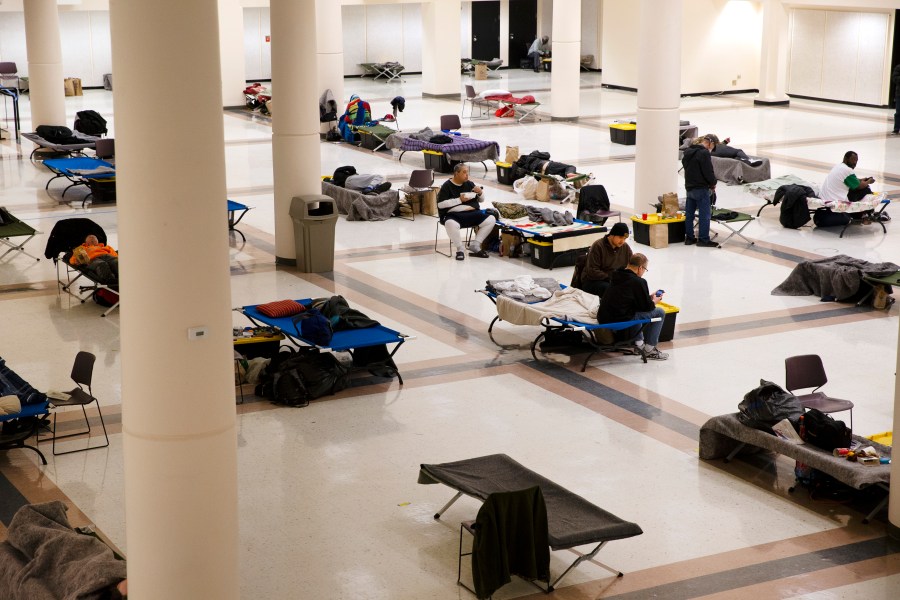Without a home in a pandemic

Facilities sheltering unhoused people have become hot spots for the spread of COVID-19, as the pandemic exposes weaknesses in the social safety net.
Shelter-in-place orders, aimed at stemming the spread of the novel coronavirus, can pose risks in communal living environments. In early April, the Centers for Disease Control and Prevention tested residents at homeless shelters in Seattle, Boston and San Francisco. One in three tested positive.
“In this environment, you are safer not being at home,” said Pebble, a resident at the Weingart Center in downtown Los Angeles, where seven residents and one staff member recently tested positive for COVID-19. (Pebble requested this pseudonym to protect her identity.) The Weingart said it has established social distancing guidelines and requires everyone to wear masks; the facility is also quarantining floors as needed to contain the virus.
According to the federal government, half a million people were homeless in the United States on any given night last year, and more than 60% of them were staying in emergency shelters or transitional programs.
Emergency shelters, by definition, provide short-term housing for people with nowhere else to stay. Transitional programs, like the Weingart, provide longer-term temporary housing and support services with the end goal of getting people into permanent housing. Both can be cramped, with dormitory-style accommodations where several people share a room and there are long waits for bathrooms and elevators.
That presents challenges for residents like Pebble — and not only when there’s a deadly virus outbreak.
At the Weingart, Pebble said the noise, the rules and the lack of privacy can make it difficult to find work and a stable place to live, both of which she needs in order to be able to move out. She hadn’t planned to stay at the Weingart long — she was leaving an abusive relationship — but she’s been there more than half a year now.
“They call me high functioning and I can’t help thinking, if I’m high functioning and I’m having so much trouble figuring this out … what are the non-high functioning people doing?” she said.
Emergency shelters and transitional housing haven’t proven entirely effective in eradicating homelessness, studies have shown.
Marian Moser Jones, a social historian at the University of Maryland, said the modern system of sheltering unhoused people is tied to two main theories that took hold among policymakers in the early 1980s. One was that many were mentally ill individuals who’d lost their housing when states closed mental hospitals in the 1960s and 1970s. The other was that homeless people had simply made bad choices and needed temporary help to get back on their feet.
Both ideas were focused on the individual’s problems, Moser Jones said, rather than looking at a broader economic reality: Cities simply didn’t have enough affordable housing stock.
“Affordable housing is one of the simplest and most overlooked solutions to homelessness,” she said.
Simply providing unhoused people with a modest place to live in areas with available affordable housing — while offering supportive services for mental health or substance abuse when needed — can be cheaper and more effective than emergency housing programs. The policy is known as “housing first.” Moser Jones said many people who land in shelters cycle back to the street, where they can get into trouble and end up in jail or an emergency room, and that “adds up to quite a bit of money.”
Under the current circumstances, unhoused people are also especially vulnerable to contracting COVID-19, inside the shelter or on the street.
To Pebble, “housing first” sounded like just what she needed to transition back to the “high-functioning” life she led before she landed at the Weingart. She has a college education and had worked for nearly a decade in the cable television industry.
“I just want it long enough to get back on my feet,” Pebble said. “Then hopefully let it be available for somebody else.”
Here’s a list of some additional reading, and material we used in our research:
- “Coronavirus Spreads to Most Skid Row Homeless Shelters, Despite Efforts to Stop It” from NBC Los Angeles
- “America’s Cities Could House Everyone If They Chose To” in the New York Times
- The United Nations’ universal declaration of human rights
- “Permanent Supportive Housing: Evaluating the Evidence for Improving Health Outcomes Among People Experiencing Chronic Homelessness” from the National Institutes of Health
- “Creating a Science of Homelessness During the Reagan Era” from the National Institutes of Health
- “Government-Run Homeless Camps Could Come To LA” from LAist
- “The Road to Reopening America Runs Through the Bathroom” in Slate
The future of this podcast starts with you.
This season of “The Uncertain Hour” tells the unheard stories of real people affected by the welfare-to-work industrial complex.
Stories like these are seldom in the limelight. It takes extensive time and resources to do this type of investigative journalism … to help you understand the complexity of our economy and to hold the powerful to account.
We need your support to keep doing impactful reporting like this.
Become a Marketplace Investor today and stand up for vital, independent journalism.


















